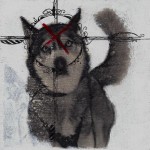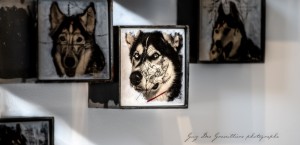About
About
-Dogs of Whistler- is an art project that took place from 2010 to 2020 by the artist Jerome Prieur.
The trigger
It all started with the shocking news about The Whistler sled dog massacre that was a controversial and horrific event about the slaughter of 56 sled dogs in Whistler, British Columbia, Canada that prompted investigation by the British Columbia SPCA and the RCMP. 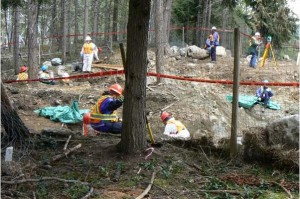
It happened on April 21st and April 23rd, 2010.
This brutal killing was performed by Robert Fawcett, an employee of Howling Dog Tours Whistler Inc., who later filed a claim at WorkSafeBC for post-traumatic stress disorder. He was allegedly told to euthanize the dogs because of a downturn in business after the 2020 winter Olympic Games.
After a veterinarian refused to euthanize the healthy dogs, Fawcett alleged”execution-style killings” in which he wrestled the dogs to the ground, stood on them, shot them or slit their throats.
Fawcett “walked away” from his crimes with a light sentence. (Sources from Wikipedia)
The mission (in art)
Prieur was grief-stricken by the massacre of these sled dogs. To this day, the unforgettable images and facts about this tragedy still haunt him. The fact that this event happened here in Canada made it worse. It also made the artist ashamed to be Canadian.
In order to remember the inhumane slaughter of these dogs and puppies, his art was the only way to cope and to honor their unjustifiable fate at the mercy of one man using a rifle, a knife and plastic bags leading these dogs into a mass grave.
The beginning

In 2011, one year had passed of boiling ideas about the series. The artist started to work on a piece about the tragedy named -Cull-. At the time, the count of the killed dogs was still unclear. This piece became the first one to represent the mass killing that was said to be over 100 dogs (including puppies).
At a later date, when the confirmed fixed number of 56 dogs was announced, the artist wrote a post on Facebook asking his followers to come up with 50+ dog names.
No one knew what it was for or what it was about.
This exercise was to collect names to title 56 individual little art pieces of sled dogs. Each dog’s name given in response from that Facebook post was used to title them. The name of the person was also added in brackets. The idea was to create an identity for each dog versus a number.
56 Dogs
Every portrait of the sled dogs was fictional. The concept in each artwork is a mix of grace and strength of the animal’s life combined with Fawcett’s killing. Halos, gentle filigrees and adorned ink details until the last brush stroke that was either a painted red X or a slash, representing either if the dog was shot in the head or cut in the throat.
The depth of the frames ranging from 2 to 4 inches represented the state of the dogs in the pen as Fawcett approached them. The deeper 4 inches frames represented the Alphas. Even though they did not stand a chance in this situation, the artist believes that the Alphas protecting instinct was strong prior to the massacre. The 3 inch frames meant confusion half way between defence and panic, and lastly, the shallowest 2 inch frames represented the feeling of complete fear and despair.
2 attempts
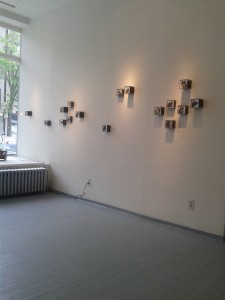
 Half way through the series, Prieur attempted to introduce the work, but failed to deliver the full concept of his statement.
Half way through the series, Prieur attempted to introduce the work, but failed to deliver the full concept of his statement.
During the Clash exhibit in 2014, (group exhibit with artist Jeff Alarie) Prieur’s first attempt was to portrait half of the work in the window. Suspended in time, as if they were rising up to the sky after the slaughter.
The second attempt was in 2015 (group exhibit with artist Isabelle Gauvin) The idea was to have the dogs randomly displayed on the south wall and let the audience guess the story behind this series.
In both cases, the essence and the narrative aspect of the work were missed completely as they were not planned well enough by Prieur.
Lessons learned, he put the project aside for a little while to concentrate on engraving for many exhibits with fellow artist Marie-Josée Roy and his solo exhibit Risques et périls (June 2019)
Yet, in between his other projects, the series was still in the works. At a slower pace, but not surrendered.
Stars align
Shortly after his solo exhibit Risques et périls, Prieur received an email from Gallery Luz in Montreal saying that her galerie III was available for February 2020 and that the exhibit will also be part of Montreal’s edition of La nuit blanche (an annual all-night or night-time arts festival of the city). Ironically, the timing was perfect, almost like an anniversary since it would be 10 years since the sled dog’s massacre and the beginning of Prieur’s art project.
Prieur went to look at the space and to his surprise; the space was very small. So tiny that it almost felt like being in a dog kennel and this was the ultimate moment of revelation. The enclosed and claustrophobic space was the key element missing to finalize the overall message and the final exhibit. Without hesitation, Prieur signed up for showing having found the right answer.
Like Prieur, other artists love large gallery spaces to properly display their work. Luz’s Galerie III was the opposite. For Prieur, It became intimate as if it was being enclosed with the sled dogs. The size of the space became an honouring and justified room because of its small scale like being caged and trapped similar to their final moment.
W.O.M (Whistler’s outdoor massacre, an installation)
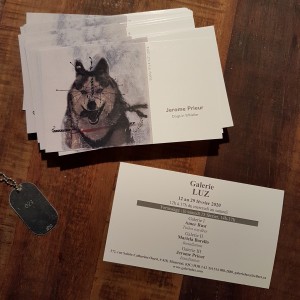 During the final weeks before setting up the exhibit, the final exhibit’s title -W.O.M- was not printed. -Dogs of Whistler- was chosen instead to represent the source and the very beginning of Prieur’s work.
During the final weeks before setting up the exhibit, the final exhibit’s title -W.O.M- was not printed. -Dogs of Whistler- was chosen instead to represent the source and the very beginning of Prieur’s work.
The artist has never done an installation before but the ideas kept pouring in. In order to honour these dogs, only an installation of the topic could deliver the full message of this long 10 years in the making.
 This task was difficult, yet the concept happened very rapidly. The gallery room consisted of 3 walls, the west wall represented Fawcett’s’ footsteps walking toward the dogs. The pieces were placed and cramped in the higher corner of the wall representing the pen they were trapped in before being killed.
This task was difficult, yet the concept happened very rapidly. The gallery room consisted of 3 walls, the west wall represented Fawcett’s’ footsteps walking toward the dogs. The pieces were placed and cramped in the higher corner of the wall representing the pen they were trapped in before being killed.
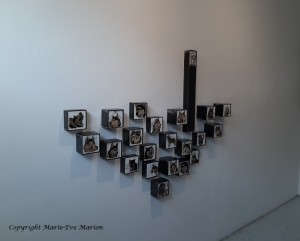
The east wall was the portrayal of the mass grave following the massacre, the bowl shape with the pieces simulated what this grave may have looked like. The piece Nora is the only piece standing out of the hole, since she was the dog that almost survived the killing.

The south wall displayed the very first piece of the project –Cull- and a video on loop. This video made by Michael Dumontier, consisted of found footage of the tragedy narrated by Prieur and author Marie-Eve Marion. It was explicit and straight to the point about the massacre but most importantly, a sincere message of hope to raise awareness towards animal abuse.
Nora
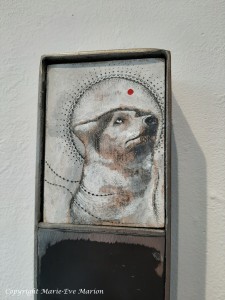 April 23, was even worse: “He noticed that a female, ‘Nora,’ who he had shot approximately 20 minutes before was crawling around in the mass grave he had dug for the animals. He had to climb down into the grave amidst the 10 or so bodies already there, and put her out of her misery.”
April 23, was even worse: “He noticed that a female, ‘Nora,’ who he had shot approximately 20 minutes before was crawling around in the mass grave he had dug for the animals. He had to climb down into the grave amidst the 10 or so bodies already there, and put her out of her misery.”
Nora was the last piece Prieur created for the exhibit and it was the most difficult one.
Prieur tried for so many years to portray her fate in his art. Many sketches and ideas, but none seemed to be adapted to her suffering and her story crawling out of the mass grave following her missed gun shot. Finally, the final idea for Nora came while listening to a song by Tvitch called –Death March-. The beat, the intensity, heaviness and the sadness of it, it finally all came together.
It was all about the frame and not the artwork itself. After all, Nora was part of the 56 slaughtered dogs. She shared the same moment and the same atrocity. But her death was very different as it took longer. The end result was to have her rising above the mass grave in this art installation.
Nora’s piece is the only one in the series to have a red marking outside her body. Instead of a gun shot or a knife to the throat, the red dot is a new beginning for Nora. Through her suffering, this red painted dot represents the will of escaping and to survive.
Nora was the most known dog to this tragedy. Her almost preserved body found by constables helped veterinarians in the field to trace what really happened to her.
Author, Marie-Eve Marion
 While W.O.M was in the making, Prieur’s friend/author Marie-Eve Marion was working of her first book -Le trèfle a 4 pattes-. An immensely touching book with stories about us and our 4 legged friends. Prieur approached Marion to collaborate as he though their mission had enormous similarities about caring, understanding and awareness toward animals. She agreed and this was the beginning of their partnership.
While W.O.M was in the making, Prieur’s friend/author Marie-Eve Marion was working of her first book -Le trèfle a 4 pattes-. An immensely touching book with stories about us and our 4 legged friends. Prieur approached Marion to collaborate as he though their mission had enormous similarities about caring, understanding and awareness toward animals. She agreed and this was the beginning of their partnership.
In addition to the book, a portion of the exhibit sales were donated to animal refuges supported but the author. Le trèfle a 4 pattes became the main sponsor and supporter to the exhibit. And this fantastic partnership is far from over. Prieur was also one of the sponsors for Marion’s second book –Florentine et Galliath- released in 2020.
Oghr
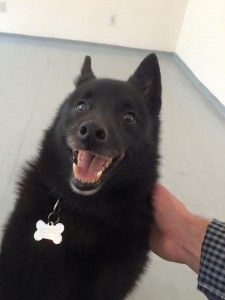 Prieur has many people to thank for the making of -Dogs of Whistler- a.k.a -W.O.M-.
Prieur has many people to thank for the making of -Dogs of Whistler- a.k.a -W.O.M-.
But most importantly, his adopted Schipperke. He was present every step of the way in preparation for this huge art project for many years.
Every time one of the 56 dogs’ artwork was completed, Oghr got an extra kiss and treat while the artist whispered in his ear the title of each piece of all dogs named by his Facebook friends who baptised them for the series.
Oghr died of old age and health complications a few months prior to the completion of the exhibit. Prieur accompanied him until his last breath.
In the heart of the artist, his art project to honour the Sled dogs was also secretly dedicated for him.
-Miss you little man-

